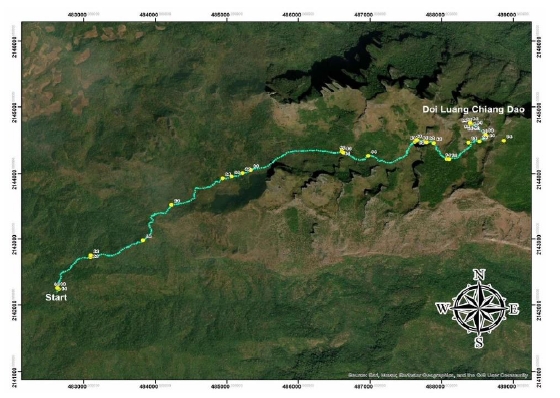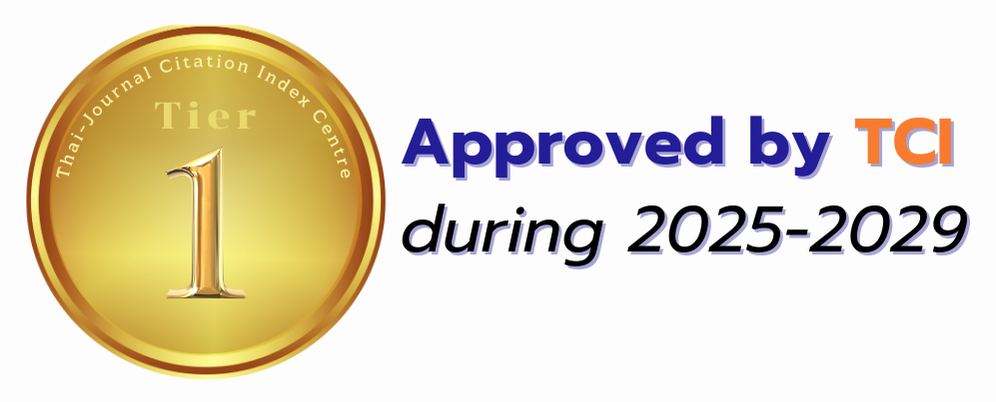Assessment of Invasive Species Severity along the Nature Trail at the Doi Chiang Dao Biosphere Reserve, Chiang Mai Province
DOI:
https://doi.org/10.34044/tferj.2025.9.1.6271Keywords:
Invasive species, assessment of severity, sub-alpine forest, plant biodiversityAbstract
Background and Objectives: Doi Chiang Dao Biosphere Reserve has been officially declared as the fifth Biosphere Reserve of Thailand, representing a critically important terrestrial ecosystem due to its significant number of endangered and endemic plant species. This designation highlights its crucial role in biodiversity conservation at both national and global scales. However, the area faces increasing threats from human activities, habitat degradation, and biological invasions. Among these threats, invasive alien plant species are particularly concerning due to their rapid spread and potential to disrupt local ecosystems, negatively affecting native biodiversity. Understanding the presence and impact of invasive plants is essential for effective conservation management. Thus, this study aimed to comprehensively examine diversity, distribution, and assess the status and severity of invasive alien plants along the nature trails within the Doi Chiang Dao Biosphere Reserve in Chiang Mai Province.
Methodology: The research employed a systematic sampling plot approach along a clearly defined elevational gradient. Sampling plots measuring of 1×1 m2 were systematically established every 100 meter above sea level, ranging from the lower altitudinal limits up to the higher altitudinal zones within the study area. This sampling protocol resulted in a total of 34 distinct plots covering various elevational habitats and ecosystems. Within each sampling plot, detailed data collection was performed, documenting all plant species encountered regardless of their growth forms or life histories, including herbs, shrubs, grasses, and other vegetation types. Plant data collection involved comprehensive photographic documentation, precise counts of individual plants per species, and careful specimen collection for later taxonomic identification. Subsequent plant identification was rigorously conducted using reference materials and confirmed with experts when necessary. Identified species were systematically analyzed to quantify density and abundance, calculate indices of species diversity and importance value, and classify invasive alien species according to established guidelines provided by Thailand’s Office of Natural Resources and Environmental Policy and Planning and the Department of National Parks, Wildlife, and Plant Conservation.
Main Results: The detailed botanical survey identified a total of 73 plant species belonging to 64 genera and 34 families within the sampled plots, indicating a substantial degree of floristic richness and diversity with an overall diversity index of 2.672. Among these identified species, seven invasive alien plant species from seven genera and four families were specifically recognized, contributing to an invasive species diversity index of 0.647. The most significant invasive alien species identified based on their ecological impact and calculated importance values were Ageratina adenophora, Bidens pilosa, and Commelina benghalensis. Additional invasive alien plant species recorded included Tithonia diversifolia, Imperata cylindrica, Parochetus communis, Sida acuta, and Malvastrum coromandelianum. The analysis of distribution patterns revealed that invasive alien plant species were predominantly observed at elevations around 1,500 meters above sea level. At this elevation, four invasive species exhibited particularly high occurrence rates, namely Ageratina adenophora, Tithonia diversifolia, Imperata cylindrica and Bidens pilosa, each having respective importance values of 14.24%, 8.42%, 9.72%, and 4.52%, respectively. This indicated that mid-elevation zones within the reserve were particularly vulnerable to biological invasions. Assessments of invasiveness severity, based on species density and their ecological importance, demonstrated that Ageratina adenophora was classified as highly invasive, significantly threatening native plant communities. The species Bidens pilosa and Imperata cylindrica showed moderate invasiveness levels, while Sida acuta, Malvastrum coromandelianum, and Tithonia diversifolia were categorized as severely invasive, though at a slightly lesser intensity compared to Ageratina adenophora. The Parochetus communis was the least invasive species detected, presenting minimal ecological disturbance. The presence and spread of invasive alien plant species within the Doi Chiang Dao Biosphere Reserve have significant implications for biodiversity conservation. Invasive plants compete directly with native and endemic species for essential resources such as nutrients, light, water, and space, potentially disrupting native ecological processes and reducing habitat quality for local flora and fauna. Human-mediated activities, including tourism, agricultural practices, and other anthropogenic disturbances, were identified as probable contributing factors to the dispersal and proliferation of these invasive plants. Furthermore, invasive alien plants can significantly alter ecosystem functions such as nutrient cycling, hydrology, soil erosion patterns, and even increase fire susceptibility. The dominance of invasive species at mid-elevational ranges suggests ecological niches that are highly vulnerable, possibly due to disturbed habitats and favorable climatic conditions. Effective management strategies must therefore consider specific ecological dynamics, elevational gradients, and potential anthropogenic drivers to mitigate the spread and establishment of invasive plants.
Conclusion: The results of this extensive study clearly indicated that invasive alien plants are widespread along the nature trails within the Doi Chiang Dao Biosphere Reserve, particularly at mid-elevation areas. Species of Ageratina adenophora emerged as the most severely invasive species, presenting an immediate and substantial threat to local biodiversity. Therefore, it is critical to establish targeted management practices, including early detection, regular monitoring, physical removal, public awareness campaigns, and strict control measures. By implementing comprehensive management strategies, stakeholders can mitigate the adverse impacts of invasive plants and effectively safeguard the ecological integrity and biodiversity of the Doi Chiang Dao Biosphere Reserve for future generations.
Downloads
References
Benedetti, Y., F. Morelli, M. Svitok, R. Santolini, P. Kadlecová, A. Cavalli, A. Strollo & Munafò, M. 2024. Identifying landscape characteristics that maximize ecosystem services provision. Sustainability 16(21): 9461. https://doi.org/10.3390/su16219461
Bhatt, M. D. 2019. Exploration of plant species in relation to invasive alien species in natural and man-made ecosystem services. International Journal of Science and Research 8(8): 1367–1374. https://doi.org/10.21275/ART2020540
Bhatta, S., B. B. Shrestha & P. Pyšek. 2023. Invasive alien plants in South Asia: Impacts and management. NeoBiota 88: 135–167. https://doi.org/10.3897/neobiota.88.104118
Biodiversity Management Division. 2018. Measures for prevention, control, and eradication of alien species. Bangkok: Office of Natural Resources and Environmental Policy and Planning. (in Thai)
Boadie-Ampong, M. & M. Nishi. 2024. Exploring the benefits of invasive alien plant species for human well-being: A systematic review of the state-of-the-art and directions for prospective research. Discover Sustainability 5(1): 329. https://doi.org/10.1007/s43621-024-00552-4
Chawhia, W., T. Lattirasuvan, P. Khonkaen & T. Yotapakdee. 2025. Valuation of Doi Luang Chiang Dao nature trail in Doi Chiang Dao Biosphere Reserve, Chiang Mai Province. Thai Journal of Forestry 44(1): 175–188. https://li01.tci-thaijo.org/index.php/tjf/article/view/262751 (in Thai)
Department of National Parks, Wildlife and Plant Conservation. 2023. Draft conservation and protection plan of Doi Chiang Dao, Chiang Mai Province. Available source. https://portal.dnp.go.th/DNP/FileSystem/download?uuid=dd16f469-e9f0-4c43-a0db-0352eaba6cda.pdf ,December 25, 2023. (in Thai)
Do, H. T. T., J. C. Grant, B. N. Trinh, H. C. Zimmer & J. D. Nichols. 2017. Diversity depends on scale in the forests of the Central Highlands of Vietnam. Journal of Asia-Pacific Biodiversity 10(4): 472–488. https://doi.org/10.1016/j.japb.2017.08.008
Dolezal, J., P. Fibich, J. Altman, J. Leps, S. Uemura, K. Takahashi & T. Hara. 2020. Determinants of ecosystem stability in a diverse temperate forest. Oikos 129(11): 1692–1703. https://doi.org/10.1111/oik.07379
Khamyong, S., A. M. Lykke, D. Seramethakun & A. S. Barfod. 2003. Species composition and vegetation structure of an upper montane forest at the summit of Mt. Doi Inthanon, Thailand. Nordic Journal of Botany 23(1): 83–97. https://doi.org/10.1111/j.1756-1051.2003.tb00371.x
Lohbeck, M., F. Bongers, M. Martinez-Ramos & L. Poorter. 2016. The importance of biodiversity and dominance for multiple ecosystem functions in a human-modified tropical landscape. Ecology 97(10): 2772–2779. http://www.jstor.org/stable/44081854
Mod, H. K., M. Chevalier, M. Luoto & A. Guisan. 2020. Scale dependence of ecological assembly rules: Insights from empirical datasets and joint species distribution modelling. Journal of Ecology 108(5): 1967–1977. https://doi.org/10.1111/1365-2745.13434
Nyamukanza, C. C. & A. Sebata. 2020. Effect of different nitrogen fertilizer application rates on Dichrostachys cinerea and Acacia karroo sapling growth, foliar nutrient and antinutrient concentrations in a southern African savanna. Ecological Research 35(1): 154–161. https://doi.org/10.1111/1440-1703.12067
Marod, D. & U. Kutintara, 2009. Forest Ecology. Aksorn Siam Printing, Bangkok, Thailand. (in Thai)
Phengklai, C. & S. Suddee. 2012. The Dioscorea species of Doi Chiang Dao with particular reference to Dioscorea collettii Hook.f. Thai Forest Bulletin (Botany) 40: 1–19. https://li01.tci-thaijo.org/index.php/ThaiForestBulletin/article/view/24320
Poopath. 2013. Invasive alien plants in protected forest areas. Department of National Parks Wildlife and Plant Conservation. (in Thai)
Pyšek, P. & D. M. Richardson. 2006. The biogeography of naturalization in alien plants. Journal of Biogeography 33(12): 2040–2050. https://doi.org/10.1111/j.1365-2699.2006.01578.x
Pyšek, P., P. E. Hulme, D. Simberloff, S. Bacher, T. M. Blackburn, J. T. Carlton, W. Dawson, F. Essl, L. C. Foxcroft, P. Genovesi, J. M. Jeschke, I. Kühn, A. M. Liebhold, N. E. Mandrak, L. A. Meyerson, A. Pauchard, J. Pergl, H. E. Roy, H. Seebens & D. M. Richardson. 2020. Scientists’ warning on invasive alien species. Biological Reviews 95(6): 1511–1534. https://doi.org/10.1111/brv.12627
Richardson, D. M. & M. Rejmánek. 2011. Trees and shrubs as invasive alien species – A global review. Diversity and Distributions 17(5): 788–809. https://doi.org/10.1111/j.1472-4642.2011.00782.x
Richardson, D. M. & P. Pyšek. 2012. Naturalization of introduced plants: Ecological drivers of biogeographical patterns. New Phytologist 196(2): 383–396. https://doi.org/10.1111/j.1469-8137.2012.04292.x
Srijan, B., P. Khonkaen, M. Norsaengsri & T. Kamyo. 2023. Assessment of habitat suitability of Burmese goral (Naemorhedus griseus) in Chiang Dao Wildlife Sanctuary, Chiang Mai Province, using the Maximum Entropy Model. Thai Journal of Forestry 42(1): 94–107. (in Thai)
Tarachai, Y., A. Hemsant, P. Chanrat & P. Patiphanthakan. 2020. Distribution of invasive alien species in Ban Pong Wildlife Conservation Area, San Sai District, Chiang Mai Province. Journal of Research Unit on Science, Technology and Environment for Learning 11(1): 1–15. https://doi.org/10.14456/jstel.2020.1 (in Thai)
UNESCO. 2021. Eight new sites in Asia and the Pacific join UNESCO’s World Network of Biosphere Reserves. Available source. https://www.unesco.org/en/articles/eight-new-sites-asia-and-pacific-join-unescos-world-network-biosphere-reserves, December 25, 2024. (in Thai)
Wei, S., L. Li, J. Lian, S. E. Nielsen, Z. Wang, L. Mao, X. Ouyang, H. Cao & W. Ye. 2020. Role of the dominant species on the distributions of neighbor species in a subtropical forest. Forests 11(3): 352. https://doi.org/10.3390/f11030352
Withayawongruchi, C., M. Poopath & P. Maneeanakekul. 2019. Species and distribution of invasive plants in Kaeng Krachan Forest Complex: Case of Thai Prachan National Park, Ratchaburi Province. Journal of Agriculture (STOU) 1(1): 29. (in Thai)
Zhao, C., Y. Zhu & J. Meng. 2022. Effects of plot design on estimating tree species richness and species diversity. Forests 13(12): 2003. https://doi.org/10.3390/f13122003







.png)





